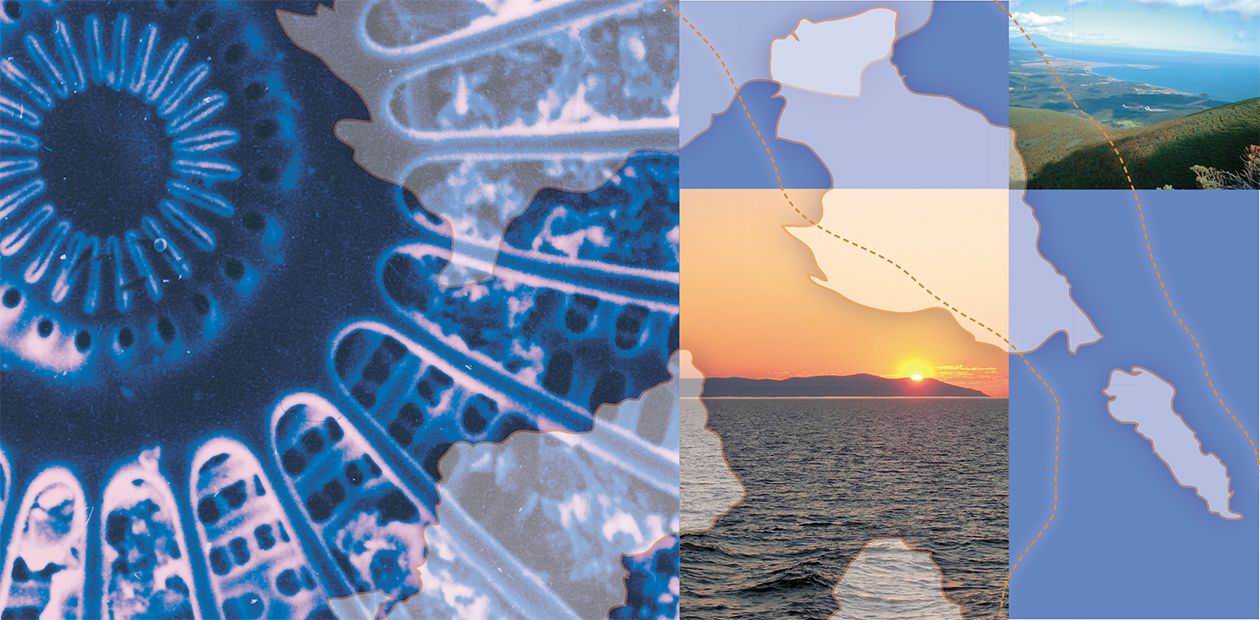Six Continents of the Eternal Life
Diatoms live either as single cells or unite in colonies of intricate shapes of chains, tubes, stars, fans, ribbons, pellicles… Being able to live in almost any aqueous medium, diatoms are ubiquitous and can be found all over the world, from the poles to the equator. They propagate quite fast, and rates of fission vary for different species and depend on the environmental factors, such as geographic latitude, season, lighting, temperature and nutrients content.
Omnipresent plants
Some diatoms, which are inhabitants of the ocean floor (the so called benthic species), are able to move on a solid substratum such as the surface of an animal. Diatoms of another kind (benthic) fasten onto various surfaces: bottom of a water body, plants or even onto ship bottoms. Certain species live on one and only certain substratum (for example, on the bodies of Antarctic whales). Planktonic diatoms can float freely in the water due to multiple inclusions of oil drops and thin porous shell. Dead cells lose this ability and sink.
The composition of diatom communities depends on ecological factors of the environment and varies through seasons.
The diatoms require many diverse chemical elements for their normal growth and reproduction. They cannot do without silicon, which constitutes their shells and which eventually limits their quantitative growth. Diatoms with rough shells consume much more silicon than thin-shelled ones, and when silica is abundant in the surrounding environment, shells are noted for very thick walls. Silicon consumption is the largest in the propagation season; as a result the silicon content in the water falls sharply and is restored only later due to its inflow from the basin’s depth. That is why even artificial addition of silica to the water causes a short sharp increase of diatom population
R. CRAWFORD: Early diatoms were unable to move and would have been very much at the mercy of the waves and the movement of the water. Later, and this certainly became possible only after a flourishing of the pennate symmetry, genera began to develop the ability to move. This involved a slit (the raphe) in the wall of the diatom along the length – in reality two slits, one at either side of the centre.
We do not yet fully understand the mechanisms of the movement of the diatoms but we are getting close. It has been established that bands of microfilaments run beneath the raphe slit and control the movement of polysaccharide threads that project through the slit, attach to the substratum and provide movement in one direction by being moved along the raphe in the opposite direction. Perhaps the most perplexing movement in diatoms concerns Bacillaria paradoxa that forms a raft of cells that move in concert to show a beautiful dance within the water as the colony extends and contracts in synchrony.
With the development of the raphe, the so-called benthic diatoms were able to exploit non-stable surfaces such as sands and muds and this has opened the way for the exploitation of any surfaces that are near enough to natural sources of light, whether they are marine or freshwater, intertidal or subtidal.
Many of these motile diatoms have developed an endogenous (in-built) rhythm that enables the diatom to migrate up or down within the sediments according to the tide (marine sites only) and or the daylight (freshwater and marine situations). There are obvious advantages to being able to escape transport by the outgoing tide or predation by grazers when not able to photosyntsize in darkness.
Diatoms are very sensitive to sodium chloride content, to which they react in different ways. For instance, the halophiles (“loving salt”) live in the sea-water and salines; the halophobes are unable to withstand even a minor salinity increase; and the so-called indifferents can live both in sweet and slightly saline waters: in rivers estuaries and sea desalinated lagoons.
Diatoms are in need of phosphates and nitrates, so increase of these elements also causes seasonal outbreaks of planktonic diatom growth. They widely use readily soluble organic substances, and so they can be sensitive “indicators” of a degree of the organic environment pollution, including that due to man (the pollution of petroleum industry, coal mines, live farming, municipal sewage, etc.). At the initial stages of changes in the habitual environment diatoms species diversity usually rises and then sharply falls, so it is possible to determine the nature of pollution before chemical analyses judging only by changes in the diatom community structure.
The most important ecological factors for diatoms are lighting and the temperature conditions. In some turbid lakes diatoms can reside only in the upper 1—2-meter layer of water, in more limpid ones they live at the depth of up to 20 m and more, and in the purest and clearest Baikal waters they inhabit even greater depths. The maximum quantity of diatoms in subantarctic waters is registered at the depth of 162 m. In tropical seas and oceans they prefer to live 5–10 m deeper to avoid direct sunlight.
As for temperature, the desirable range is from 0 to 50 ° C, though here diatoms can noticeably vary too.
Diatoms are sensitive to cosmic factors. For example, when the size of a “hole” in the ozone layer over Antarctica reaches its maximum, the population of plankton, the main constituent of which is diatoms, appreciably decreases. This adversely affects the food chain of the whole southern ocean ecosystem.
It should be mentioned that diatoms are liable to considerable seasonal variations of population. That is the reason why a diatom community may noticeably change during a year even in the same basin. This effect can be observed on a huge scale in seas and oceans. For instance, in summer and autumn one can see from the space a deep green stripe up to a thousand kilometers wide, which is spread over the surface of the Pacific Ocean. This stripe is caused by high concentration of diatoms.
Ice aboriginals
Whoever from the South is dreams about the Arctic, and more specifically the High Canadian Arctic, sees vast ice-covered regions with well-known and large charismatic animals such as polar bears, seals and muskoxen. When Arctic sea ice forms in the fall, it reaches a maximum extent of about 14 million square kilometers with a maximum thickness of approximately 2 m by the end of winter.
A unique characteristic of this harsh habitat, at least for us, is that sea ice offers a physical support for many organisms. For instance, sea ice is inhabited by a great diversity of microorganisms such as viruses, bacteria, algae, protozoans and metazoans, while large mammals and humans use this solid ice surface for sustainable activities such as traveling, feeding and hunting. The immediate under-ice habitat is also known to concentrate Arctic cod, which in turn attract the seals that feed on them.
Because of their large size (one-hundredth of a millimeter to almost half a millimeter), diatoms have been known to occur in Arctic sea ice for nearly 165 years. More than 300 species of ice microalgae have been reported from the High Canadian Arctic, belonging to various algal groups and this is not the whole list. Sea ice offers a substrate for microscopic algae to develop, whether they are living at the snow-ice interface, in the middle of the ice matrix or in the lower sections. If you travel during the spring season on an icebreaker in the High Arctic, the evidence of the microalgae can be seen in the characteristic discoloration of the lower or bottom parts of sea ice overturned by the ship track.
Ice microalgae contribute between 3 and 25 % of the total annual primary production in Arctic continental shelves and can reach 50 % in the central Arctic Ocean.
Some like it hot
In thermal stability diatoms are inferior only to cyanobacteria. Diatoms can live successfully in thermal waters with temperature from 50 °C (Azerbaijan) to 77 °C (Kamchatka). In very hot waters one can often find distinctive algal mats, two-layer pellicles with cyanobacteria forming the top layer and diatoms — the bottom one, as though they were hiding inside from the scalding waters.
Rise of water temperature causes a decrease in species variety, but on the other hand these selected species develop abundantly. In thermal springs of the world there are more than 600 species and intraspecific taxons of diatoms altogether. The overwhelming majority (up to 98 %) of thermae inhabitants are pennate diatoms, which can be partly explained by the nature of thermal springs themselves: they are usually shallow, with rapid currents — and this is not acceptable for the centric diatoms that are more inclined to the planktonic mode of life.
In some cases microscopic diatoms can be observed not only through a microscope ocular, but also through a spaceship viewing port!It is significant that no abnormal forms of diatoms were observed in thermal waters, though there are some deviations from the canon.
Phycologists consider that thermophilic vegetation consists of cold water seaweeds that managed to adapt to high temperatures. On the whole, this statement represents the facts, but when researching thermal springs, scientists generally describe previously unknown species, kinds and forms of diatoms. In due course it will be clarified whether these diatoms are obligatory thermophiles.
















